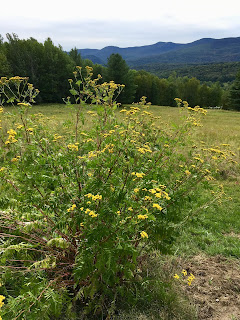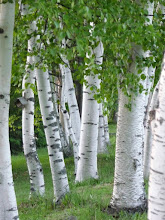Over the weekend, the temperatures were forecast to dip into the mid thirties, which lit a fire under my butt to get the indigo harvested.
A few of the plants had started to bloom.
Batman helped me cut all the stems and strip the leaves. When I weighed them I discovered that we had FIVE pounds of leaves!
On Saturday afternoon I brewed a one pound jar of leaves and these are the results (above). The yellow is a result of the tansy "tea" I brewed on Saturday as well.
Look here to see that fun.
On Monday, I brewed a second pound of indigo and these are the results (above, drying...and below, pressed). The remaining three pounds of indigo leaves are on a screen in the woodshed, drying for later use. But I've got to do more research to figure out how
that may work!
I did some fabric manipulation or
shibori with clothespins, clamped mason jar lids, stitched resist and fabric bunching.

To see my indigo dye day from 2016,
look here.
My 2017 indigo harvest was successful, but my dye day was a tear producing flop.
That's why I have started a dye journal, as recommended by so many natural dyers. It's a place to keep track of all aspects of the gentle work of dyeing. It's a bit like alchemy...we can set things up for success, but it helps to be open to Mother Nature's whims.
These are the notes I posted on Instagram, explaining the methods I used...
I am using cotton, linen and some of my grandmother’s vintage tablecloths and hankies. I have scoured with soda ash, mordanted with aluminum acetate and done a wheat bran bath before I dye, following instructions in Kristine Vejar’s book The Modern Natural Dyer. (Mordant is not required for indigo, but now I have a generous supply of prepared fabric for other dyes I may try this fall). We harvested 5 pounds of indigo leaves from the garden. I used one pound on Saturday, I have another pound cooking on the stove now and three pounds are drying on a screen in the woodshed. I am following instructions for a (fresh) Japanese Indigo Vat found in Chris McLaughlin’s sweet book, A Garden to Dye For. The tansy was a simple “tea”, one pound of blossoms simmered in water for about 20 minutes.
Growing, dyeing and sewing with color from our gardens here at our
bit of earth remains one of my deepest pleasures.
xo


























